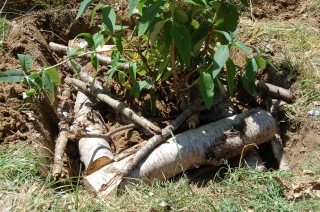Have you ever wanted to bake when it was 100 degrees outside? Maybe you needed a cake for a summer birthday or some other crazy reason. Either way it is way too hot to be baking, unless you have central air. I don’t. I am also always looking for ways to save money on electricity or just some strange new project to try. So I bought this book. This book teaches you how to build some simple solar cookers and how to use them. It is full of recipes at varying levels of difficulty. The recipes all seem fairly easy, I guess that difficulty level means how many hours of good sunlight they need to work well. Either way, this is going to be my project for the next few days. We’ll see how it goes.
Archive for June, 2013
Cooking with Sunshine
Posted in Cooking, Off-Grid Utilities, tagged cooking, solar on June 29, 2013| Leave a Comment »
Seed Saving: Amish Snap Peas
Posted in Gardening, Seeds, tagged garden, seed saving, veggies on June 28, 2013| Leave a Comment »
The easiest kinds of plants to learn to save  seeds for is peas and beans. If you already save dried peas or beans, do exactly the same thing but save the beans or peas to be used as seeds. If you are unfamiliar with this process, it is very easy. The pea pod in the picture is an Amish snap pea. As the season for them passed, I left quite a few pods on the vine to dry. Once the vines are completely dead and the pea pods are dried, then collect them. This may be a month or so after you would normally harvest them to eat. Then all you need to do to get to the seeds is simply pop open the pod without sending the peas flying everywhere. Be sure that the peas are completely dry and store in an air tight glass container. These seeds can store well as long as five years. Beans and other kinds of peas are saved exactly the same way.
seeds for is peas and beans. If you already save dried peas or beans, do exactly the same thing but save the beans or peas to be used as seeds. If you are unfamiliar with this process, it is very easy. The pea pod in the picture is an Amish snap pea. As the season for them passed, I left quite a few pods on the vine to dry. Once the vines are completely dead and the pea pods are dried, then collect them. This may be a month or so after you would normally harvest them to eat. Then all you need to do to get to the seeds is simply pop open the pod without sending the peas flying everywhere. Be sure that the peas are completely dry and store in an air tight glass container. These seeds can store well as long as five years. Beans and other kinds of peas are saved exactly the same way.
My Flower Garden: Angelica
Posted in Herbs, Perennials, Plant Info, tagged beneficial insects, flowers, garden, perennial on June 24, 2013| Leave a Comment »
As I had mentioned before, a flower garden can be a form of organic pest control if you plant the right flowers. So what are the right kinds of flowers to plant? Angelica is the first flower I started in my garden. Initially, I chose this flower because I wanted some perennials that could grow in partial shade and attract beneficial insects, and these were on sale. It turns out that these were a great choice for me.
 Angelica is a biennial plant which means that it will grow for about two seasons. It likes partial shade and loamy soil (although mine is growing quite well in the clay that I have). They like cool moist climates and can get from 4-6 feet tall. The small flowers are white or greenish white and grow in large clusters. It is part of the Apiaceae family along with dill, caraway, queen anne’s lace and chevril. There are also a couple of poisonous plants that are very similar to these plants, so be careful if you find it wild.
Angelica is a biennial plant which means that it will grow for about two seasons. It likes partial shade and loamy soil (although mine is growing quite well in the clay that I have). They like cool moist climates and can get from 4-6 feet tall. The small flowers are white or greenish white and grow in large clusters. It is part of the Apiaceae family along with dill, caraway, queen anne’s lace and chevril. There are also a couple of poisonous plants that are very similar to these plants, so be careful if you find it wild.
Angelica can be eaten in many ways. The leaves have a sort of celery flavor and can be used in place of lovage in many recipes. The stalks are slightly sweet almost licorice like and are often candied when harvested young. The stalks are also good to flavor liquor and the leaves go well with rhubarb. Even the roots can be eaten. Check out this site for a couple of angelica recipes: http://www.mountainvalleygrowers.com/angarchangelica.htm
Angelica is also part of the grouping Dong-quai, second most common herb used in China, second to ginseng. Angelica contains compounds called coumarins. Coumarins can be used to reduce swelling, especially in the lymph nodes and associated with arthritis. Angelica can be used for women to help relieve symptoms of PMS and hot flashes. You should not take angelica if you are pregnant! Angelica contains bergapten, which can be used to treat skin conditions and linalool and borneol which are antibacterial and antifungal. The boiled roots can be used to speed up healing. It also increases immunity and circulation, stimulates appetite, relaxes muscles and many other things.
When I bought my first few angelica plants, I did not know any of this. All I really knew about it was that it was good for attracting beneficial insects. It’s tiny flowers make it easy for small bugs like parasitic wasps to get to the pollen. Parasitic wasps are good for your garden because they use big bugs like tomato horn worm to grow their babies. This is turn kills the tomato horn worm, organically protecting your garden from them. There are also many pollinators that will be attracted to your flower garden and angelica. I was happy to see that they bloomed in early spring which helps to get the pollinators to your garden right away. I now need to add some flowers that will bloom right after the angelica to keep the pollinators around.
Now that I know all I do about angelica, I will be able to take full advantage of the plants next year. I plan on saving seed (I’ll talk about this later) and learning how to use all the parts of the angelica plant to their full potential. I can’t believe I was so lucky to stumble across such a great plant!
Hugelkultur Mounds
Posted in Gardening, Permaculture, tagged compost, fertilizer, perennial on June 22, 2013| 2 Comments »
The perfect way to fertilize a tree or bush is a hugelkultur mound. This will provide food for years with only a little effort in the beginning. It retains water so you don’t need to provide supplemental, just rain water should do. It gets nice and warm so that if you are planting trees or bushes that should be in a warmer climate, they have a much better chance of surviving.
So, what is a hugelkultur mound, now that I know I want one? Basically it is a pile of rooting wood around your tree or bush that is covered with dirt. It rots and breaks down just like a compost pile which provides nutrients, the spongy water retaining texture and the heating up.
It is very easy to set one up. When I planted the bush here in the picture, I just set it up around the planting. I started out by digging an extra wide hole with the deep spot in the deep spot in the middle for the bush to
 go. I put a handful of leaves into the hole and put the bush on top of that. Then I placed four large logs each on one side of the bush in the hole. Then I filled in the spaces with large and then small sticks trying to fill in most of the gaps. Over the top of that, I put a couple handfuls of leaves over all the wood around the base of the plant. Cover the leaves with the dirt you dug out of the hole. I did a lot of stomping on the dirt all around the plant because I’m sure that it is going to pack down at some
go. I put a handful of leaves into the hole and put the bush on top of that. Then I placed four large logs each on one side of the bush in the hole. Then I filled in the spaces with large and then small sticks trying to fill in most of the gaps. Over the top of that, I put a couple handfuls of leaves over all the wood around the base of the plant. Cover the leaves with the dirt you dug out of the hole. I did a lot of stomping on the dirt all around the plant because I’m sure that it is going to pack down at some
point. I did water it some, but it is supposed to rain tomorrow, so I didn’t go too crazy. I assume that when it rains, it will all fall in and I will have to top it off. Either way, this bush should do fantastic as soon as it settles in. The logs I used were already started rotting, so I don’t think it will be long before that bush can begin to benefit from it.
Birdhouses
Posted in Animals, Permaculture, tagged building, family, helpful critters on June 21, 2013| Leave a Comment »
Since permaculture is also organic we don’t use any chemicals on anything. This means we need another way to control bugs that bother our garden plants. Birds eat lots of bugs so we should do our best to make friends with some birds. I put birdhouses all over my yard.

This is my very first visitor. I should point out too that if you put the houses or a post out in your garden, then when the birds poop, they are adding nitrogen to your garden. I have seen one garden where the post can be moved around depending on where you need the nitrogen. Permaculture is all about many uses for everything.
My whole family helped in the birdhouse making. We made a day of it. We all sat down together and painted and then I fed everyone dinner. It was a nice family gathering and I got quite a few nice painted birdhouses out of it. I think we will do it again next year.


